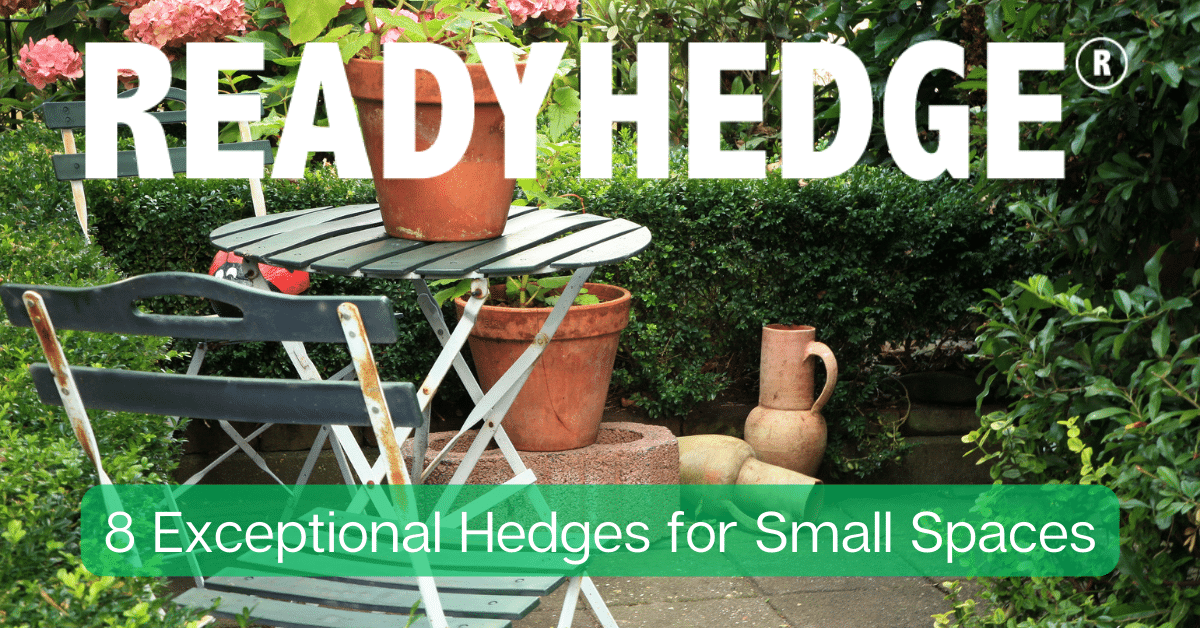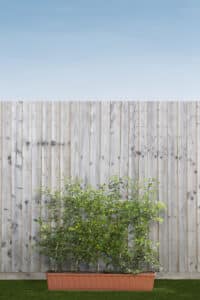Understanding the Importance of Hedges in Small Spaces
Hedges are a fantastic way to add structure, privacy, and beauty to your garden. But when you’re working with a small space, choosing the right hedge becomes even more critical. The best narrow hedge plants in the UK are those that can thrive in limited space, provide the aesthetics you desire, and require a level of care that you’re comfortable with. In this post, we’ll explore the top 10 hedging plants that are perfect for small spaces.
Top 8 Hedges for Small Spaces
-
- Common Box (Buxus sempervirens): Box is a classic choice for hedges, known for its dense, compact growth and small, glossy leaves. It’s an evergreen, providing year-round privacy and greenery. Hardy and adaptable, boxwood can be pruned into a variety of shapes and sizes, making it a versatile choice for any garden. It’s also resistant to most pests and diseases. Boxwood is perfect for formal gardens or creating defined spaces.
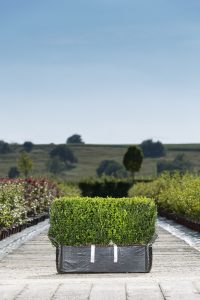
- Privet (Ligustrum): Privet is a fast-growing hedge, ideal for those who want to create privacy quickly. It’s semi-evergreen, retaining its leaves in all but the harshest winters. Privet produces clusters of fragrant white flowers in the summer, followed by black berries, providing seasonal interest and attracting wildlife. It’s also tolerant of urban pollution and a variety of soil conditions, making it a practical choice for city gardens.
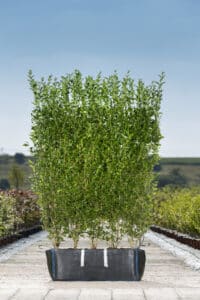
- Holly (Ilex): Holly is a great choice for adding colour to your garden. Its glossy green leaves and bright red berries provide a beautiful contrast and a festive touch in the winter. Holly is evergreen, providing year-round privacy. It’s also very hardy, resistant to pests and diseases, and can tolerate a variety of soil conditions. Holly hedges can also serve as a protective barrier due to their prickly leaves.
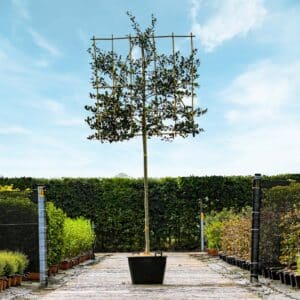
- Yew (Taxus baccata): Yew is a slow-growing, long-lived hedge that’s perfect for formal gardens. It’s an evergreen with dark green needles and red berries, providing year-round interest. Yew can be pruned into a variety of shapes and sizes, and it’s tolerant of shade, making it a versatile choice. It’s also resistant to most pests and diseases. However, note that all parts of the yew are toxic if ingested.
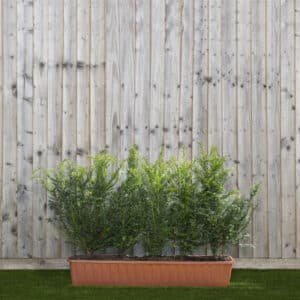
- Beech (Fagus sylvatica): Despite their potential for large growth, Beech hedges can be a wonderful addition to smaller spaces when properly maintained. Their hardiness and adaptability to a variety of soil types make them an excellent choice for urban gardens with diverse soil conditions. The leaves, which turn a captivating golden brown in the autumn and often remain on the hedge throughout the winter, provide year-round privacy even in compact spaces.This feature can be particularly beneficial in smaller gardens where privacy might be a concern. Furthermore, their resistance to most pests and diseases makes them a low-maintenance option, ideal for small-space gardeners who need to maximise their time and resources. With regular pruning to control their size, Beech hedges can offer a blend of beauty, privacy, and resilience in any small garden.
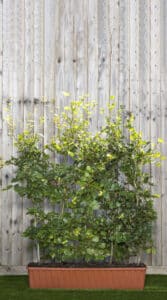
- Hornbeam (Carpinus betulus): Hornbeam is similar to beech but is better suited to wetter soils. It’s an excellent choice for creating a tall, dense hedge. Hornbeam’s leaves turn a beautiful golden yellow in the autumn, providing seasonal interest. It’s also very hardy and resistant to most pests and diseases. Hornbeam can tolerate a variety of conditions, including urban pollution, making it a practical choice for city gardens.
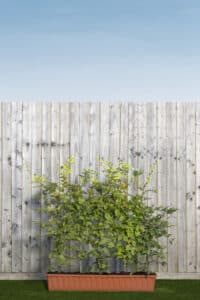
- Laurel (Prunus lus. Angustifolia): Laurel is a large, evergreen shrub, perfect for creating a dense, tall hedge. Its glossy green leaves and clusters of fragrant white flowers provide year-round interest. Laurel is very hardy and can tolerate a variety of soil conditions, including heavy clay. It’s also resistant to most pests and diseases. Laurel can grow quite large, so it’s best suited to larger gardens.
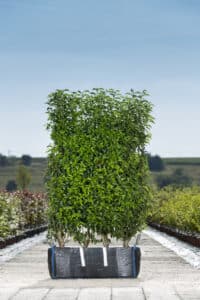
- Hawthorn (Crataegus monogyna): Hawthorn is a native British hedge that’s perfect for attracting wildlife. Its beautiful white flowers bloom in the spring, followed by red berries in the autumn, providing seasonal interest. Hawthorn is very hardy and can tolerate a variety of soil conditions. It’s also resistant to most pests and diseases. Hawthorn hedges can serve as a protective barrier due to their thorny branches.
- Common Box (Buxus sempervirens): Box is a classic choice for hedges, known for its dense, compact growth and small, glossy leaves. It’s an evergreen, providing year-round privacy and greenery. Hardy and adaptable, boxwood can be pruned into a variety of shapes and sizes, making it a versatile choice for any garden. It’s also resistant to most pests and diseases. Boxwood is perfect for formal gardens or creating defined spaces.
Remember, the best hedge for your garden depends on your specific needs and conditions. Consider factors like the amount of sunlight your garden gets, the type of soil you have, and how much maintenance you’re willing to do when choosing a hedge.
Caring for Your Small Hedge Plants
Watering: All plants need water to survive, and hedges are no exception. While the exact watering needs will depend on the type of hedge and your local climate, most hedges need regular watering, especially during dry periods. Newly planted hedges need to be watered more frequently, usually once a day, to help them establish their root systems. Once established, hedges typically need watering once a week during dry weather. It’s best to water deeply and infrequently, rather than little and often, to encourage the roots to grow deep into the soil. This makes the hedge more drought-resistant and stable.
Pruning: Pruning is essential for maintaining the shape of your hedge and promoting dense growth. The best time to prune depends on the type of hedge. Evergreen hedges, like boxwood and yew, are best pruned in late spring to early summer. Deciduous hedges, like beech and hornbeam, can be pruned in late summer. When pruning, make sure to cut the hedge so that it’s wider at the base than at the top. This shape allows sunlight to reach the lower branches and prevents the base of the hedge from becoming bare. Remember to use sharp, clean pruning tools to make clean cuts and prevent the spread of diseases.
Feeding: Hedges, like all plants, need nutrients to grow. Most hedges will benefit from an annual application of a balanced, slow-release fertilizer in the spring. This provides the nutrients they need for healthy growth. Some hedges, like boxwood and yew, may also benefit from additional feeding in the fall.
Mulching: Mulching is a great way to conserve soil moisture, suppress weeds, and improve soil fertility. Apply a layer of organic mulch, like compost or well-rotted manure, around the base of your hedge in the spring. This will help retain moisture in the soil during the summer and provide nutrients as it breaks down.
Specific Care Requirements: Some hedges may have specific care requirements. For example, rose hedges need regular feeding with a rose-specific fertilizer and protection from pests like aphids and black spots. Holly hedges prefer acidic soil and may need an ericaceous fertilizer if your soil is alkaline. Always do some research or consult with a gardening expert to understand the specific needs of your chosen hedge.
Remember, a well-cared-for hedge not only looks beautiful but also provides a habitat for wildlife, a windbreak, and privacy. With the right care, your hedge can become a highlight of your garden.
Conclusion: Transform Your Small Space with the Perfect Hedge
Choosing the right hedges for small spaces can make a big difference in the look and feel of your garden. Whether you want to create privacy, add visual interest, or define different areas in your garden, a hedge plant can meet your needs. Remember, the best small hedge plants are those that match your garden conditions and personal preferences. So, don’t be afraid to choose a plant that you love. After all, your garden is an extension of your home, and it should reflect your style.

